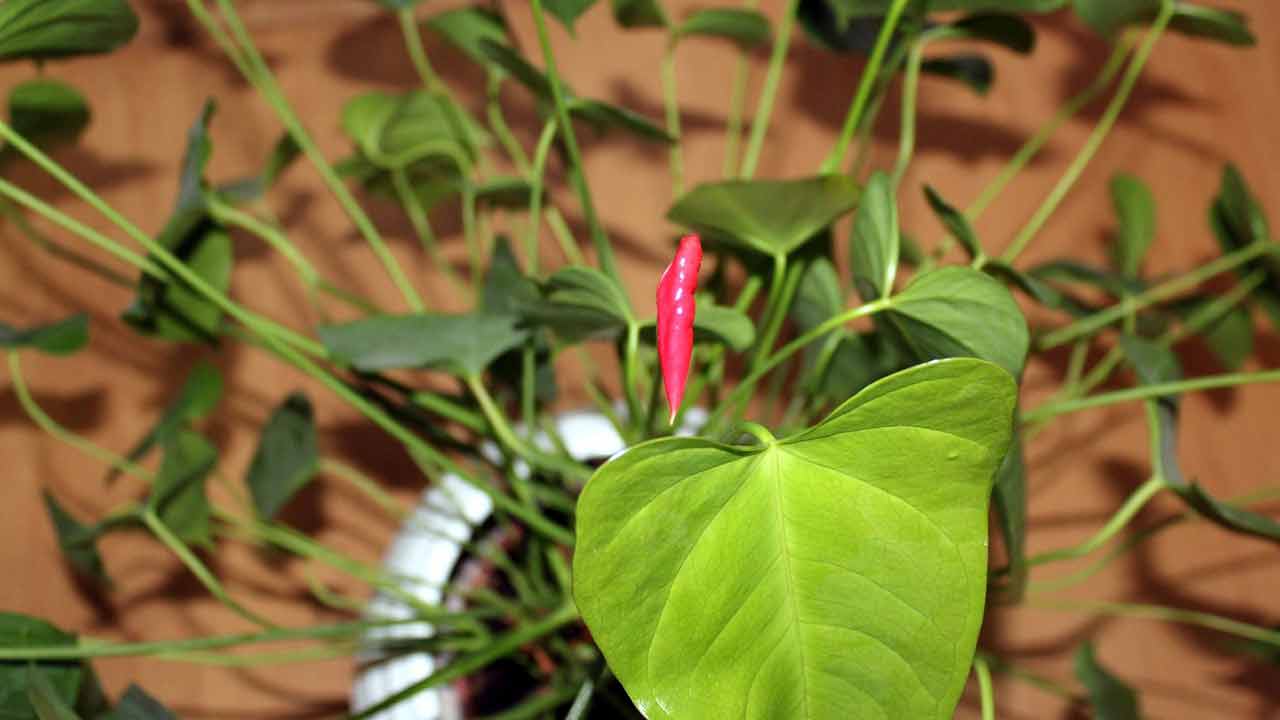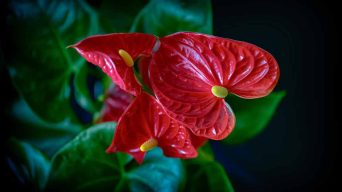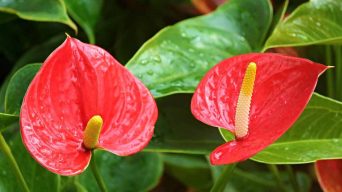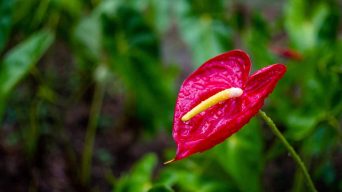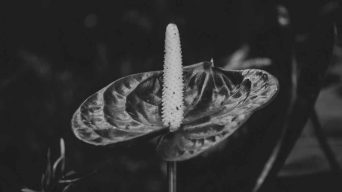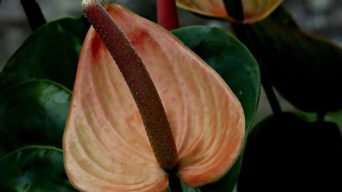Anthuriums, also known as flamingo flower or laceleaf, are beautiful flowers that come in various colors, shapes, and sizes.
Though they’re often used as houseplants, they can also be found in gardens and greenhouses.
One common problem with anthuriums is that they can become leggy or stretch out too much. This can be caused by several factors, such as too little light or excessive fertilization.
If your anthurium is looking leggy, there are a few things you can do to fix the problem.
Here you will find everything you need to know about how to fix a leggy anthurium.
What Causes an Anthurium to Become Leggy?
There are a few different reasons why an anthurium might become leggy.
The most common reasons are:
1. Not Enough Light
Anthuriums need bright light to thrive, but they will also tolerate some shade. If your anthurium is not getting enough light, it will start to stretch out in search of sunlight.
Anthurium plants need at least four hours of bright, indirect light daily. If you can provide more than that, they will be even happier.
If your anthurium is not getting enough light, it will start to stretch out in search of sunlight. The best way to fix this problem is to move your plant to a location that gets more light.
2. Excessive Fertilization
Anthuriums are heavy feeders and need to be fertilized regularly. However, it’s possible to overfertilize them, which can cause leggy growth.
Too much fertilizer can cause the plant to grow faster than it can support itself, resulting in weak and leggy stems.
Also, high nitrogen levels in fertilizer can cause leggy growth.
If you think you might have overfertilized your anthurium, flush the soil with water to remove any excess fertilizer. Then, cut back on the amount of fertilizer you’re using.
3. Rootbound
If a plant is rootbound, it means the roots have filled up the pot and have nowhere to go. This can stunt the plant’s growth and cause leggy stems.
A rootbound anthurium won’t be able to take up nutrients and water as efficiently, which can also cause leggy growth.
If your anthurium is rootbound, you’ll need to repot it into a larger pot. Be sure to use a well-draining potting soil mix and provide adequate drainage.
How To Tell if Your Anthurium is Leggy
There are a few different ways to tell if your anthurium is leggy.
Here are some signs to look for:
1. The Plant Is Taller Than It Should Be
A leggy anthurium will be taller than a healthy plant. If your anthurium is stretching out and getting leggy, it’s probably not getting enough light.
When anthuriums are grown in low light conditions, they will stretch out in search of sunlight. This causes the plant to have large stems with few leaves.
2. The Stems Are Thin and Weak
Leggy anthuriums will have thin, weak stems. This is caused by the plant growing too fast and being unable to support itself.
The stems of a leggy anthurium will be long and spindly, and they will likely break easily.
3. There Are Few Leaves
Leggy anthuriums will have fewer leaves than healthy plants. This is because the plant uses all its energy to grow tall in search of light.
When an anthurium becomes leggy, it will drop its lower leaves to conserve energy.
4. The Flowers Are Fewer and Smaller
Leggy anthuriums will also have fewer and smaller flowers. The plant uses all its energy to grow tall instead of producing flowers.
Anthuriums grown in low light conditions will often produce fewer and smaller flowers.
5. The Plant Is Pale Green
If your anthurium is leggy, it will likely be pale. This is because the plant is not getting enough light.
The light green color is a result of the chlorophyll in the leaves not being able to produce enough food for the plant.
6. The Plant Leaves Are Drooping
Leggy anthuriums will often have drooping leaves. This is because the plant is not getting enough light.
The plant won’t be able to produce enough energy to support the leaves, and anthuriums will droop as a result.
7. There Is Little to No New Growth
If your anthurium is not getting enough light, it will stop producing new growth. This lack of new growth can cause the plant to become leggy.
Anthuriums need at least four hours of bright, indirect light daily. They will stop producing new growth if they do not get enough sunlight.
8. The Plant Looks Unhealthy
In general, a leggy anthurium will look unhealthy.
It will be tall and spindly with few leaves and small flowers. The stems will be thin and weak, and the plant may start to lean to one side.
A leggy anthurium is not getting enough light and cannot produce the food it needs to survive. As a result, the plant will look unhealthy.
How To Fix a Leggy Anthurium
There are a few different ways to fix a leggy anthurium.
Here are some tips:
1. Provide More Light
The first and most crucial step is to provide more light.
Anthuriums need at least four hours of bright, indirect light daily. If your anthurium is not getting enough light, it will become leggy.
Moving the plant to a brighter location is an easy way to provide more light. However, be careful not to place the plant in direct sunlight.
Anthuriums can tolerate bright light, but they will scorch if placed in direct sunlight.
Indoor anthurium plants can be placed near an east- or west-facing window. This will provide the plant with the bright, indirect light it needs.
Outdoor anthurium plants can be placed in a semi-shady location. This will provide the plant with the bright, indirect light it needs.
If you cannot provide more light, you can try using grow lights. Grow lights are artificial lights that mimic the sun’s rays.
They are a great way to provide extra light for plants
2. Prune the Plant
Pruning is a great way to encourage new growth and fix a leggy anthurium.
To prune an anthurium, cut back the stem to about 6 inches (15 cm) above the soil. This will encourage the plant to produce new growth.
You also need to prune off any leaves that are yellow or brown. These leaves no longer produce the plant’s food and need to be removed.
Pruning anthurium plants is a great way to encourage new growth and fix a leggy plant.
3. Stop Fertilizing
If you are fertilizing your anthurium plant, stop.
Fertilizers can cause the plant to grow too fast and become leggy.
Anthuriums only need to be fertilized once a month during the growing season. If you are fertilizing more than this, you are likely causing the plant to become leggy.
You must flush the potting mix with water to remove the excess fertilizer. To do this, water the plant until water runs out of the drainage holes.
You may need to do this a few times to remove all the excess fertilizer from the potting mix.
4. Give the Plant a Support
If your anthurium plant is tall and spindly, you may need to give it support.
A support will help the plant stay upright and prevent it from falling over.
You can use a bamboo stake, trellis, or other support to help your anthurium plant stay upright.
5. Repot the Plant
If your anthurium plant is rootbound, it will become leggy.
Rootbound plants are often pot-bound and need to be repotted.
To repot a rootbound anthurium plant, select a pot 2-3 inches (5-8 cm) wider than the current pot.
Remove the plant from its current pot and gently loosen the roots. Place the plant in the new pot and fill it in with the fresh potting mix.
Don’t water the plant for a few days to allow the roots to recover from the transplant.
How To Prevent a Leggy Anthurium
The best way to prevent a leggy anthurium is to provide the plant with the proper care.
Here are some tips:
1. Provide Enough Light
Anthuriums need bright, indirect light to thrive. They need at least four hours of bright, indirect sunlight each day. If you can provide more light, that’s even better.
You can place your anthurium near an east- or west-facing window. If you live in a tropical climate, you can also place your plant outdoors in a shady spot.
2. Turn the Plant Regularly
Anthuriums grow best when they’re turned regularly. Every week or two, turn the plant so that all sides of the plant get equal amounts of light.
If your plant only gets light from one side, it will start to grow towards the light. This can cause the plant to become leggy.
3. Trim the Plant Regularly
To keep your anthurium looking full and healthy, trim the plant regularly. Remove any yellow or brown leave and any flowers that have died.
Regular trimming will encourage the plant to produce new growth, which will help prevent legginess.
4. Fertilize the Plant Properly
Anthuriums need to be fertilized regularly to stay healthy. Use a well-balanced fertilizer that is high in phosphorus.
Avoid using high nitrogen fertilizers, as these can cause the plant to grow too fast and become leggy.
Fertilize your plant once a month during the growing season. You can fertilize your plant year-round if you live in a tropical climate.
5. Pinch the Plant
Pinching the plant will encourage it to produce new growth.
To pinch an anthurium, use your fingers to remove the growing tip of the plant. This will cause the plant to produce new growth, which will help prevent legginess.
Pinching should be done every few weeks during the growing season.
Final Thoughts
Anthuriums are one of the most popular houseplants. They’re easy to care for, they bloom frequently, and they add a touch of tropical elegance to any room.
However, anthuriums can sometimes get leggy and lose their compact shape.
If your anthurium is looking a bit leggy, don’t worry!
With some pruning and proper care, you can return it to look its best.

